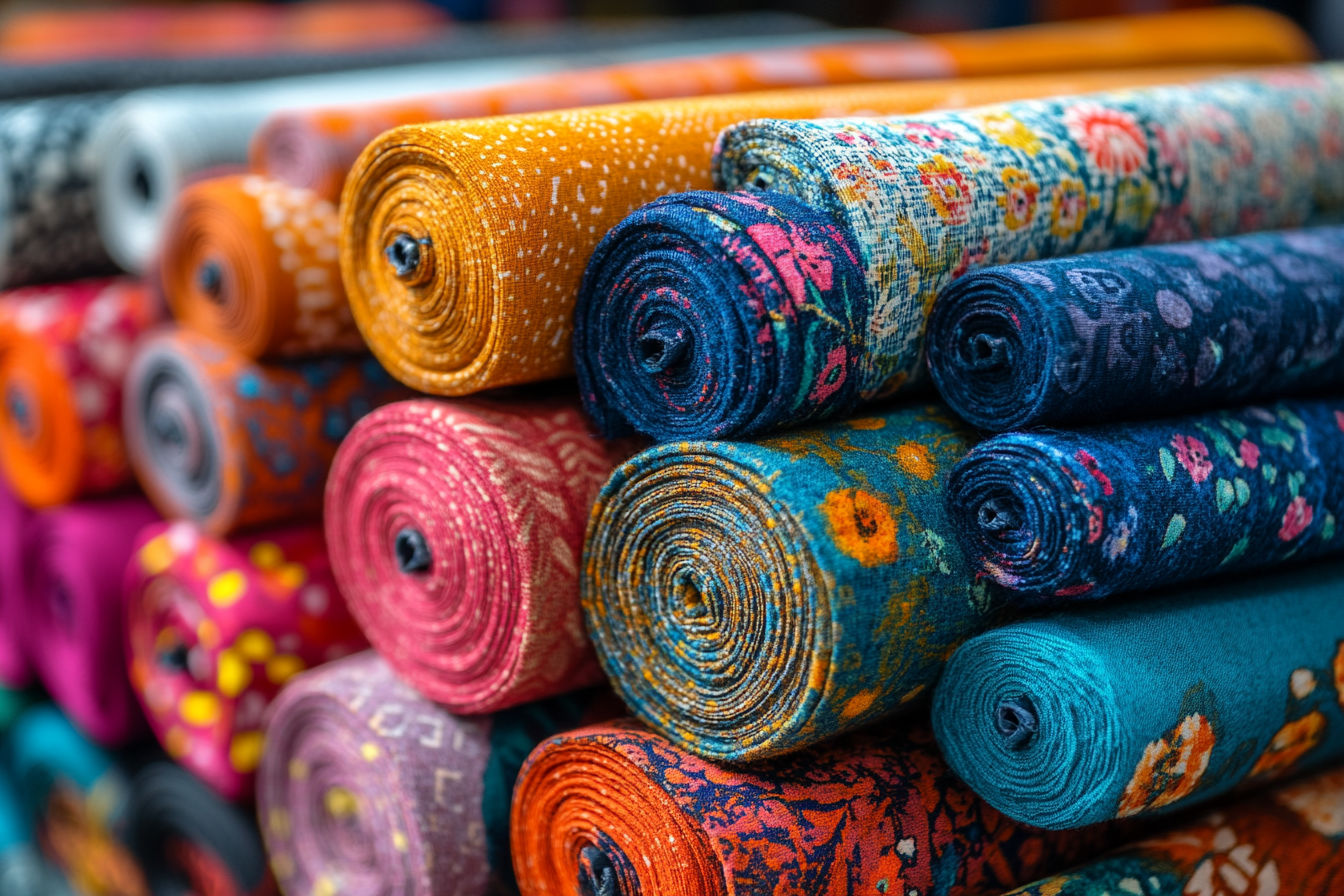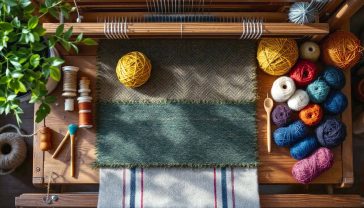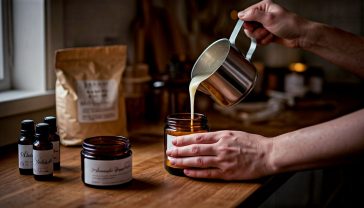Polycotton: The Versatile Blend Transforming Textiles
Ever wondered what makes polycotton the go-to fabric for everything from clothes to home decor? Dive into its world and discover secrets that will change the way you see textiles.

This post may contain affiliate links. If you make a purchase through these links, we may earn a commission at no additional cost to you.
In the fabric world, polycotton is a remarkable blend that combines the best of two worlds: cotton’s natural comfort and polyester’s durability. This fabric has grown in popularity across various sectors, from fashion to home furnishings, due to its versatility and cost-effectiveness. But what exactly is it, and why has it become such a sought-after material in recent years?
Understanding Polycotton
Polycotton is a blended fabric that marries the qualities of polyester, a synthetic fibre, with those of cotton, a natural fibre harvested from cotton plants. The blend typically incorporates a mix of around 65% cotton and 35% polyester, although the exact ratio can vary depending on the fabric’s intended use. This strategic combination results in a material that combines polyester’s strength and easy-care properties with cotton’s softness, breathability, and absorbency.
Properties of Polycotton
The appeal of polycotton lies in its balanced properties, making it a highly durable yet comfortable fabric choice:
- Durability: It’s celebrated for its exceptional durability. Including polyester fibres enhances the fabric’s strength, making it resistant to wear and tear and prolonging its lifespan even after frequent use and washes.
- Breathability and Comfort: Thanks to the cotton component, it retains a level of breathability that contributes to its overall comfort. This makes it suitable for clothing and bedding materials, providing a soft touch against the skin and allowing air circulation.
- Wrinkle and Shrink Resistance: Polyester’s characteristics provide resistance to wrinkles and shrinkage, offering a practical advantage for everyday use. Garments and linens require less ironing and maintain their shape and size better over time than their all-cotton counterparts.
- Absorbency: While polyester is not known for its absorbency, polycotton allows the fabric to absorb moisture, making it a comfortable choice for clothing and bed linens. This property, combined with polyester’s quick-drying capability, make for an excellent material for active wear and towels.
The Advantages of Polycotton
Polycotton’s widespread adoption can be attributed to several key advantages:
- Versatility in Applications: Its adaptable nature makes it a favourite across numerous industries, from clothing and uniforms to bedding and upholstery.
- Easy Care and Maintenance: The fabric’s blend ensures it can be easily washed and dried without requiring special care, making it a convenient choice for busy households.
- Affordability: Combining polyester, which is generally cheaper to produce, with cotton results in a cost-effective fabric that doesn’t sacrifice quality for price.
- Environmental Aspect: When made with recycled polyester, it can offer a more sustainable option, reducing the environmental impact associated with fabric production.
The unique blend of polyester and cotton fibres offers a versatile, durable, and comfortable fabric choice, balancing the benefits of both materials. Its adaptability and practical advantages make it a staple in various applications, from fashion to home furnishings.
The Practical Uses of Polycotton
It’s carved out a significant niche in various industries. Its balanced attributes make it a go-to fabric for many applications, from everyday clothing to specialized industrial materials.
Polycotton Clothing
It’s widely used in the fashion industry thanks to its versatility and durability. It’s a popular choice for casual wear, like t-shirts and trousers, and work uniforms due to its ability to withstand frequent washing and ease of care. Sportswear also benefits from polycotton’s moisture-wicking properties, drawing sweat away from the body to keep wearers comfortable during physical activity.
Most common uses in clothing:
- T-shirts
- Polo shirts
- Casual trousers and shorts
- Work uniforms
- Sportswear
It’s an ideal fabric for clothing due to its cotton and polyester fibres blend. The cotton provides breathability and comfort, while the polyester adds durability, wrinkle resistance, and ease of care. This combination makes polycotton clothing suitable for a wide range of everyday wear, as it can withstand frequent washing and maintain its shape and colour over time.
In work uniforms and sportswear, its moisture-wicking properties help keep the wearer cool and dry by drawing sweat away from the body, enhancing comfort during physical activity.
Home Textiles
It’s used in bedding, curtains, and upholstery. Its resistance to wrinkles and shrinkage makes it ideal for bedsheets and pillowcases that maintain a crisp look with minimal ironing. Polycotton curtains offer durability and ease of maintenance, while their use in upholstery ensures that furniture covers are durable and easy to clean.
Most common uses in home textiles:
- Bedsheets and pillowcases
- Curtains and drapes
- Upholstery fabric
- Tablecloths and napkins
- Towels
It’s a popular choice for home textiles because it combines the softness and absorbency of cotton with the strength and durability of polyester. This blend results in fabrics that are easy to care for, resistant to wrinkles and shrinkage, and can withstand frequent use and laundering.
In the case of bedsheets and pillowcases, it provides a crisp, comfortable sleeping surface that requires minimal ironing. It offers a durable and easy-to-clean option for curtains and upholstery that can endure daily use and exposure to sunlight without fading or deteriorating quickly.
Polycotton Industrial Applications
Beyond clothing and home textiles, it’s also employed in various industrial settings. Its strength and durability make it suitable for automotive upholstery, where it can endure the wear and tear of daily use while providing a comfortable seating surface.
In the medical field, it’s used for scrubs, lab coats, and hospital linens, combining the need for hygiene and comfort with the practicality of easy laundering and durability.
Most common uses in industry:
- Automotive upholstery
- Medical scrubs and lab coats
- Hospital linens (sheets, gowns, and towels)
- Uniforms for various industries
- Filtration fabrics
The unique blend of properties makes it suitable for various industrial applications where durability, comfort, and practicality are essential. In the automotive industry, it’s used for vehicle upholstery because it can withstand the wear and tear of daily use while providing a comfortable seating surface that is easy to clean. Polycotton offers a combination of comfort, durability, and hygiene for medical applications.
The fabric’s ability to withstand frequent laundering at high temperatures ensures that it can be kept clean and sterile, which is crucial in healthcare settings. Polycotton’s moisture-wicking properties also help medical professionals feel comfortable during long shifts. In filtration applications, the blend of fibres can effectively balance filtration efficiency and durability, making it suitable for various industrial filtration needs.
Considerations and Disadvantages of Polycotton
Despite its many advantages, it’s not without its considerations. Due to its breathability, 100% cotton may outperform it in extremely hot or outdoor environments. While less likely to catch fire than pure polyester, it’s not as fire-resistant as pure cotton, making it less suitable for specific high-risk environments.
1. Reduced Breathability Compared to Pure Cotton
- Issue: While more breathable than 100% polyester, it falls short of pure cotton’s natural ability to wick moisture and allow air circulation.
- Impact: In extremely hot, humid, or outdoor environments, it can trap heat and moisture against the skin, leading to discomfort during prolonged wear or intense physical activity.
- Example: For summer clothing or bedding in tropical climates, 100% cotton often outperforms it, due to its superior ventilation.
2. Compromised Fire Resistance
- Issue: It’s less flammable than pure polyester, which can melt or ignite easily, but it doesn’t match the natural fire resistance of 100% cotton.
- Impact: In high-risk environments—such as kitchens, industrial settings with open flames, or for protective gear—polycotton’s blend of synthetic fibres increases its flammability risk compared to pure cotton.
- Consideration: It’s not an ideal choice for applications requiring stringent fire safety standards, like certain work uniforms or children’s sleepwear.
3. Lack of Specialisation
- Issue: Polycotton’s balanced mix of durability (from polyester) and softness (from cotton) makes it a “jack of all trades, master of none.”
- Impact: In scenarios where the specific strengths of either pure cotton or pure polyester are critical, it may underperform:
- Pure Cotton: Preferred for its hypoallergenic properties, softness, and biodegradability (e.g., in luxury bedding or baby clothes).
- Pure Polyester: Chosen for its exceptional durability, water resistance, and wrinkle-free nature (e.g., in outdoor gear or heavy-duty upholstery).
- Example: For high-end fashion prioritizing natural fibres or rugged sportswear needing maximum toughness, polycotton might not meet expectations.
4. Environmental and Sustainability Concerns
- Issue: The polyester component in is derived from petroleum-based synthetic fibres, which are non-biodegradable and contribute to microplastic pollution when washed.
- Impact: Unlike 100% cotton, which is fully biodegradable, polycotton’s environmental footprint is larger, making it less appealing for eco-conscious consumers or industries aiming to reduce waste.
- Consideration: Recycling polycotton is also more complex due to its blended nature, limiting its sustainability compared to single-fibre fabrics.
5. Potential for Pilling and Wear Over Time
- Issue: The polyester can also lead to pilling—small balls of fibre forming on the surface—especially in blends with a higher polyester ratio or lower-quality production.
- Impact: This affects the fabric’s appearance and texture over time, reducing its aesthetic appeal and longevity compared to pure cotton, which tends to wear more evenly.
- Example: In frequently washed items like towels or casual shirts, it may show signs of ageing faster than anticipated.
6. Less Luxurious Feel
- Issue: While soft and comfortable, it lacks the premium, natural hand-feel of 100% cotton, especially high-quality variants like Egyptian or Pima cotton.
- Impact: For applications where tactile luxury is a priority—such as high-end bedding, towels, or formal attire—it can feel less refined or sophisticated.
- Consideration: Consumers seeking a “natural” or organic experience may find the synthetic element off-putting.
7. Moisture Retention and Odor Issues
- Issue: Polyester’s lower absorbency means polycotton doesn’t wick moisture as effectively as pure cotton, potentially leading to dampness and odor retention.
- Impact: In activewear or bedding, this can result in a less fresh feel after sweating or prolonged use, as bacteria may thrive in the retained moisture.
- Example: Athletes or individuals prone to sweating might prefer cotton’s superior moisture management.
8. Dyeing and Colour Limitations
- Issue: The blend of natural cotton and synthetic polyester can complicate dyeing processes, as each fibre absorbs dyes differently.
- Impact: This may result in uneven coloration or less vibrant hues compared to single-fiber fabrics, limiting its appeal for bold, uniform designs.
- Consideration: In fashion or decor where precise colour matching is key, it might not deliver the desired consistency.
9. Allergen and Sensitivity Risks
- Issue: Though rare, it can cause skin irritation or allergic reactions in highly sensitive individuals, unlike pure cotton, which is naturally hypoallergenic.
- Impact: For people with dermatological conditions or preferences for natural fibres, polycotton may not be a safe or comfortable choice.
- Example: Baby clothing or medical textiles often favor 100% cotton to avoid potential irritation.
Polycotton’s versatility comes at the cost of trade-offs. Its hybrid nature sacrifices some of the standout qualities of pure cotton (breathability, fire resistance, biodegradability) and pure polyester (durability, water resistance), making it a compromise rather than an optimal solution in certain cases. For applications requiring extreme performance, environmental purity, or a luxurious feel, it may fall short, leaving users to weigh its practical benefits against these notable downsides.
Care and Maintenance
Maintaining polycotton textiles is straightforward, contributing to its popularity. Machine washing in cold water on a gentle cycle is generally recommended to preserve the fabric’s texture and colour. Tumble dry on a low setting helps prevent shrinkage and damage to the fibres.
A low to medium heat setting is advisable to avoid melting or scorching the polyester component when ironing. Promptly treating stains and avoiding harsh chemicals will keep items looking their best for longer.
As we move forward, it’s clear that polycotton’s unique blend of features—balancing durability with comfort and ease of care with affordability—makes it a compelling choice for a wide range of uses.
From the practical to the aesthetic, it continues to leave its mark on the textile industry, combining the best qualities of its component fibres to meet the demands of modern consumers and enterprises alike.
The Future of Polycotton in Textiles
As the textile industry evolves, polycotton stands at the forefront of innovation and sustainability. Its unique combination of polyester and cotton fibres offers a glimpse into the future of fabrics, where versatility, durability, and eco-friendliness converge.
Innovation and Trends in Polycotton
The ongoing development aims to enhance its performance and environmental footprint. Advances in textile technology have led to the creation of blends that are even more durable, comfortable, and resistant to wear and tear. Furthermore, there’s a growing trend towards using recycled polyester in blends, reducing the reliance on virgin materials and minimizing the fabric’s environmental impact.
Manufacturers also experimented with new blend ratios and treatments to boost functionality. For example, antimicrobial finishes and enhanced moisture-wicking capabilities are being developed to meet the specific needs of workwear, sportswear, and medical textiles. These innovations are driven by consumer demand for high-performance, sustainable fabrics that do not compromise comfort or durability.
Sustainability and Eco-friendliness
The shift towards sustainability in the textile industry highlights polycotton’s potential as a more eco-conscious choice. Incorporating recycled polyester makes the fabric’s production process less resource-intensive, reducing its carbon footprint and water usage. This approach aligns with global efforts to combat textile waste and promote circular economies, where materials are reused and recycled to extend their lifecycle.
Consumer Preferences and Market Trends
Consumers increasingly value the balance between quality, performance, and environmental impact when choosing fabrics. The natural and synthetic fibre blend, meets these criteria by offering a durable, versatile, and often more affordable alternative to pure cotton or polyester fabrics. The fabric’s ability to adapt to various applications—from fashion to furnishings—makes it a popular choice among designers and manufacturers looking to cater to eco-conscious consumers.
Conclusion
Polycotton embodies the textile industry’s shift towards more sustainable, versatile, and high-performance materials. Its blend of polyester and cotton fibres leverages the strengths of both components, resulting in a fabric that is well-suited to a wide range of applications.
As technological advancements and sustainability efforts continue to shape the industry, polycotton is poised to play a significant role in the future of textiles. Its evolution reflects the growing emphasis on materials that meet consumers’ functional needs and align with environmental values and market trends.






